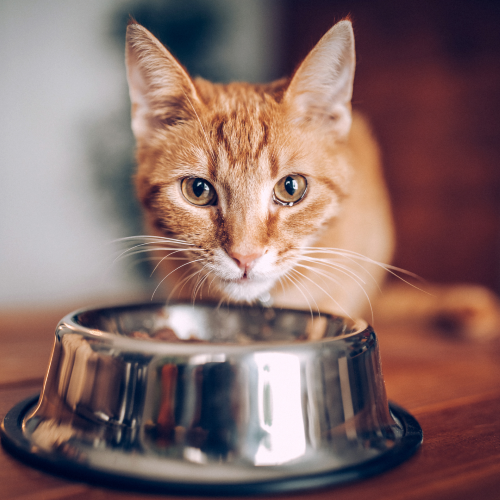Can Dog’s Eat Cat Food? The Risks, Reasons and Better Alternatives
One of the most common questions dog owners ask is: Can dogs eat cat food? Whether it’s because their dog has sneaked a few bites from the cat’s bowl or they’ve run out of dog food and are considering using cat food as a temporary solution, this topic is crucial to understand. While cat food may seem like an appealing option to dogs due to its strong aroma and high protein content, it is not formulated for a dog’s long-term nutritional needs. This article explores why dogs are attracted to cat food, the potential health risks, and the best alternatives.
Why Do Dogs Like Cat Food?
Dogs often find cat food irresistible for several reasons:
High Protein and Fat Content: Cat food is designed for obligate carnivores, meaning it has higher levels of protein and fat than dog food. This makes it more aromatic and palatable for dogs.
Stronger Smell and Taste: Due to its meat-based ingredients and added flavors, cat food often has a richer taste and a more appealing scent than regular dog food.
Novelty Factor: Dogs love trying new foods, and if they have access to a cat’s food bowl, curiosity and opportunity will drive them to sample it.
Competitive Eating Behavior: In multi-pet households, some dogs may try to eat the cat’s food out of competition, even if they have their own meal.
The Risks of Feeding Cat Food to Dogs
While an occasional nibble of cat food is unlikely to harm your dog, regular consumption can lead to several health issues.
1. Nutritional Imbalance
Dog food is formulated to provide a balanced diet with the right mix of proteins, carbohydrates, fats, vitamins, and minerals. Cat food, on the other hand, is higher in protein and fat and lacks essential nutrients that dogs need, such as:
Different Vitamin and Mineral Ratios: Cat food should contain more taurine and vitamin A, which are essential for cats but not required in the same amounts for dogs.
Lack of Fiber: Dogs need more dietary fiber for digestive health, which is often lacking in most cat food.
2. Gastrointestinal Upset
The high protein and fat levels in cat food can be too rich for a dog’s digestive system, potentially leading to:
Diarrhea
Vomiting
Gas and Bloating
3. Pancreatitis
Long-term consumption of fatty foods, including cat food, can lead to pancreatitis, a serious and potentially life-threatening condition. Symptoms include:
Abdominal pain
Vomiting
Loss of appetite
Lethargy
4. Obesity and Weight Gain
Cat food is calorie-dense, and dogs that consume it regularly may experience unhealthy weight gain. Overweight dogs are at risk for:
Diabetes
Joint Problems
Heart Disease
5. Food Allergies and Intolerances
Some dogs may have allergic reactions to certain ingredients in cat food, leading to:
Itchy Skin
Ear Infections
Digestive Distress
What to Do If Your Dog Eats Cat Food
If your dog eats a small amount of cat food accidentally, it’s usually not a cause for concern. However, if they consume it regularly or in large quantities, watch for signs of gastrointestinal distress or allergic reactions. If symptoms persist, consult a veterinarian.
Better Alternatives to Cat Food for Dogs
If you need a substitute for dog food or want to offer your dog a high-protein alternative, consider these safer options:
1. High-Quality Dog Food
Opt for premium dog food that meets AAFCO (Association of American Feed Control Officials) or FEDIAF standards. Look for brands that are life stage appropriate.
2. Fresh Meat (In Moderation)
Cooked lean meats like chicken, turkey, and beef can provide a protein boost without the risks associated with cat food.
3. Egg
Eggs are a great source of protein and essential nutrients. Cooked eggs can be a healthy addition to your dog’s diet.
4. Dog-Specific High-Protein Diets
If your dog requires a higher protein intake, consult your vet about switching to a high-protein dog food formula instead of using cat food.
5. Vegetables and Fruits
Dogs can benefit from fiber-rich foods such as:
Carrots
Green beans
Pumpkin
Blueberries
These provide essential vitamins and minerals while supporting digestion.
Conclusion
While dogs may love the taste of cat food, it is not a suitable long-term dietary option. The nutritional imbalance, high fat and protein content, and risk of serious health issues make cat food a poor substitute for dog food. If you need an alternative, opt for high-quality dog food or safe, protein-rich options like cooked lean meats or eggs. Always consult with a veterinarian before making any significant changes to your dog’s diet.
References
Association of American Feed Control Officials (AAFCO) guidelines on pet nutrition.
American Veterinary Medical Association (AVMA) studies on obesity and dietary needs in dogs.
National Research Council’s Nutrient Requirements of Dogs and Cats (2006).
Veterinary Clinics of North America: Small Animal Practice, Nutrition & Disease Management.
By understanding why dogs are drawn to cat food and the potential health risks involved, pet owners can make informed decisions to ensure their dogs stay happy and healthy. Want to check if your dog’s diet is meeting their needs? Complete the FREE DIET ASSESSMENT HERE or book a consultation online now

